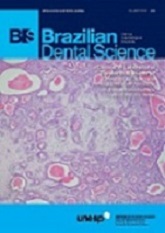Evaluation of 0.5% peracetic acid and 2.5% sodium hypochlorite on smear layer removal of root canal instrumented by three rotary systems
DOI:
https://doi.org/10.14295/bds.2014.v17i1.959Abstract
Objective: The aim of this study was to evaluate the effect of 0.5% peracetic acid solution and 2.5% sodium hypochlorite solution on smear layer removal of root canal walls after rotary instrumentation. Material and methods: Sixty single-rooted human teeth with standardized length had their canals instrumented by three rotary systems (Biorace, MTwo and Endowave), varying the irrigation solution, as follows (n=10): G1- Biorace System + 0.5% peracetic acid solution; G2- Biorace System + 2.5% sodium hypochlorite solution; G3- MTwo System + 0.5% peracetic acid solution; G4- MTwo System + 2.5% sodium hypochlorite solution; G5- Endowave System + 0.5% peracetic acid solution; G6- Endowave System + 2.5% sodium hypochlorite solution. After instrumentation, the roots were cleaved and the dentin walls were evaluated by SEM at x500 and x2000 magnification for assessing the cleaning of the root canals at the cervical, middle and apical thirds. The analyzed area was quantified according to the total number of tubules present and the percentage of open tubules at each region. Data were submitted to statistical analysis by ANOVA and Tukey tests, at the significance level of 5%. Results: There were no statistical significant differences among the experimental groups. In all groups the smear layer removal at cervical and medium thirds was higher than that of apical third. Conclusion: It was concluded that the cleaning obtained at the apical third was lower in all groups studiedand neither the instrumentation technique nor the irrigating solution was able to promote total smear layer removal from root canal walls.
KEYWORDS: Peracetic acid; Root canal irrigants; Scanning electron microscopy; Sodium hypochlorite.
Downloads
Downloads
Published
How to Cite
Issue
Section
License
Brazilian Dental Science uses the Creative Commons (CC-BY 4.0) license, thus preserving the integrity of articles in an open access environment. The journal allows the author to retain publishing rights without restrictions.
=================




























